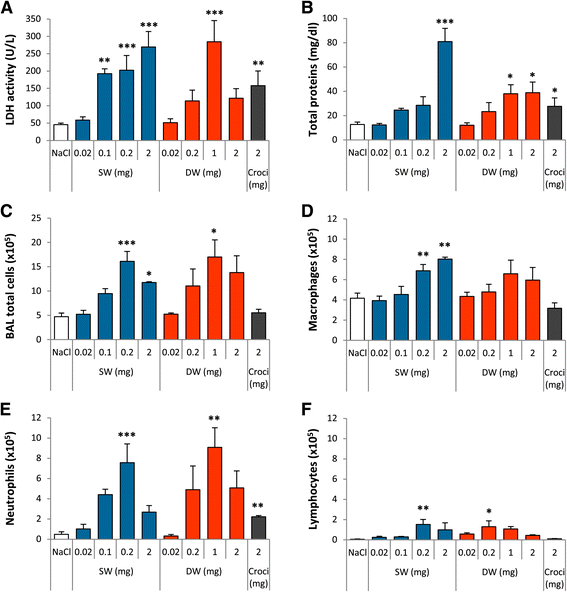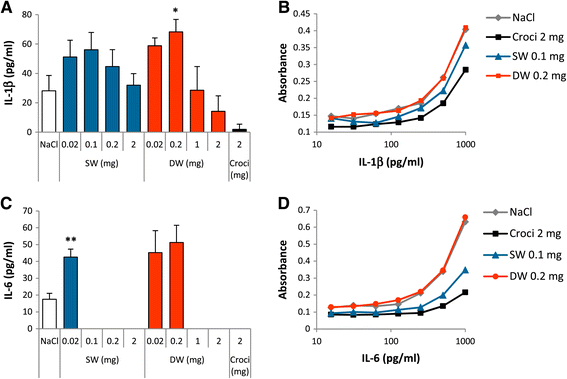Nanometer-long Ge-imogolite nanotubes cause sustained lung inflammation and fibrosis in rats
- PMID: 25497478
- PMCID: PMC4276264
- DOI: 10.1186/s12989-014-0067-z
Nanometer-long Ge-imogolite nanotubes cause sustained lung inflammation and fibrosis in rats
Abstract
Background: Ge-imogolites are short aluminogermanate tubular nanomaterials with attractive prospected industrial applications. In view of their nano-scale dimensions and high aspect ratio, they should be examined for their potential to cause respiratory toxicity. Here, we evaluated the respiratory biopersistence and lung toxicity of 2 samples of nanometer-long Ge-imogolites.
Methods: Rats were intra-tracheally instilled with single wall (SW, 70 nm length) or double wall (DW, 62 nm length) Ge-imogolites (0.02-2 mg/rat), as well as with crocidolite and the hard metal particles WC-Co, as positive controls. The biopersistence of Ge-imogolites and their localization in the lung were assessed by ICP-MS, X-ray fluorescence, absorption spectroscopy and computed micro-tomography. Acute inflammation and genotoxicity (micronuclei in isolated type II pneumocytes) was assessed 3 d post-exposure; chronic inflammation and fibrosis after 2 m.
Results: Cytotoxic and inflammatory responses were shown in bronchoalveolar lavage 3 d after instillation with Ge-imogolites. Sixty days after exposure, a persistent dose-dependent inflammation was still observed. Total lung collagen, reflected by hydroxyproline lung content, was increased after SW and DW Ge-imogolites. Histology revealed lung fibre reorganization and accumulation in granulomas with epithelioid cells and foamy macrophages and thickening of the alveolar walls. Overall, the inflammatory and fibrotic responses induced by SW and DW Ge-imogolites were more severe (on a mass dose basis) than those induced by crocidolite. A persistent fraction of Ge-imogolites (15% of initial dose) was mostly detected as intact structures in rat lungs 2 m after instillation and was localized in fibrotic alveolar areas. In vivo induction of micronuclei was significantly increased 3 d after SW and DW Ge-imogolite instillation at non-inflammatory doses, indicating the contribution of primary genotoxicity.
Conclusions: We showed that nm-long Ge-imogolites persist in the lung and promote genotoxicity, sustained inflammation and fibrosis, indicating that short high aspect ratio nanomaterials should not be considered as innocuous materials. Our data also suggest that Ge-imogolite structure and external surface determine their toxic activity.
Figures






References
-
- Schinwald A, Murphy FA, Prina-Mello A, Poland CA, Byrne F, Movia D, Glass JR, Dickerson JC, Schultz DA, Jeffree CE, Macnee W, Donaldson K. The threshold length for fiber-induced acute pleural inflammation: shedding light on the early events in asbestos-induced mesothelioma. Toxicol Sci. 2012;128:461–470. doi: 10.1093/toxsci/kfs171. - DOI - PubMed
-
- Vietti G, Ibouraadaten S, Palmai-Pallag M, Yakoub Y, Bailly C, Fenoglio I, Marbaix E, Lison D, van den Brule S. Towards predicting the lung fibrogenic activity of nanomaterials: experimental validation of an in vitro fibroblast proliferation assay. Part Fibre Toxicol. 2013;10:52. doi: 10.1186/1743-8977-10-52. - DOI - PMC - PubMed
Publication types
MeSH terms
Substances
LinkOut - more resources
Full Text Sources
Other Literature Sources
Medical

